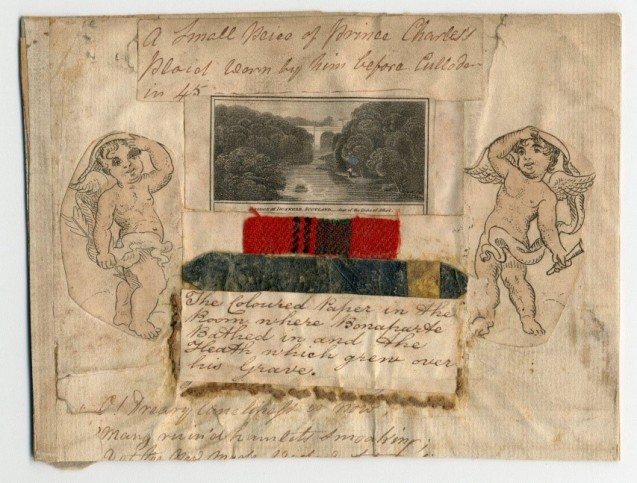In this respect, the last of the great bicentenaries, namely that of the death of Napoleon 1821-2021, promises some fine discoveries, as the auctions of the last few weeks prove. On 11 December, 2020, a copy of the report made by the workman who in 1821 created the coffin made of tin for Napoleon’s corpse was sold in the United States. Though well-known, this document is nevertheless remarkable. In the same sale were: a report intended for Hudson Lowe written by George Nicholls, the British orderly officer inside Longwood House in 1819-1820; a profile portrait of the Emperor sketched by Madame Bertrand dated 1820; not to mention letters and reports by Napoleon and elements from the carriage captured at Waterloo. A few weeks later in Paris, part of the unpublished correspondence of Emmanuel Pons de Las Cases with Bertrand, Montholon and Napoleon III, for the years 1830-1840, was sold. Even more recently in England, a key apparently taken from Longwood House in September 1822 (see the Talking Point by Michel Dancoisne-Martineau) went for a tidy sum. At the same time, a Parisian bookseller has put up for sale a manuscript of a text on Austerlitz dictated by Napoleon to Bertrand, as well as several documents from the Bertrand collection that was dispersed in the 1980s.
At the other end of the scale, hidden in amongst the motley collection of pieces sold in the United States stands an even stranger item. On a rectangle of paper, an unknown individual brought together:
- “A small piece of Prince Charles’s [Stuart, Bonnie Prince Charlie] plaid worn by him before Culloden in 45”;
- An engraving from the estate of the Duke of Athol whose son, Lord George Murray, was Stuart’s lieutenant in the 45 Rebellion;
- The first stanza of a little-known Jacobite song;
- “The coloured paper in the room where Bonaparte bathed in [sic]” at Longwood House;
- Some blades of “the heath which grew over his grave” on St Helena.
These pieces are framed by two putti glued haphazardly on what seems to be ordinary paper. Perhaps the ensemble was framed.

As we know, after 1821, St Helena and Longwood House became places of remembrance, and many visitors left with bits of the plants surrounding the tomb or with parts of the imperial dwelling in their pockets. Helenian botanical and historical reliquaries are relatively common. However, a combination of such heterogeneous “relics” raises questions. Why bring together memories of Bonnie Prince Charlie and the man the British nicknamed “Boney”? Is it simply because their nicknames rhyme? Possibly someone saw broad similarities in the stories of these two adversaries of England.
In July 1745, Charles Edward Stuart, grandson of James II of England and VII of Scotland, driven from power by the Glorious Revolution of 1688, landed in Scotland, determined to regain the throne in the name of his father (James III Stuart) who had appointed him Prince Regent. In his undertaking, in which religion played an important role, he was supported by the Jacobite party and with a selection of Scottish clans as his army. After some success, he was defeated at the battle of Culloden on 16 April 1746 by the English (and indeed Scots!) troops under the Duke “Butcher” Cumberland. As part of the subsequent harsh repression of the opponents (for which the Duke got his nickname) George III had the law of Habeas Corpus suspended. In order not to be executed on the spot, Charles Stuart fled first to Benbecula, then “over the sea to Skye”, and from there to France into exile. He ended his life in Italy in 1788.
Like Walter Scott, Scottish admirers of Bonnie Prince Charlie were still numerous in 1815. Not without a certain romanticism, they made the connection between the destinies of Charles Stuart and the Emperor. Napoleon landing at Golfe-Juan, after his exile from the Isle of Elba, reminded them of Charles Edward Stuart who had come to Scotland to regain power. The tragic end of the Hundred Days at Waterloo, ending in exile on St Helena, reminded them of Culloden and the final exile of their prince to France and Italy. The failed attempt in July 1815 by Napoleon’s British supporters (there were indeed some!) to save the Emperor using the law of Habeas Corpus painfully reminded them of the tragic suspension of the text in 1746.
However, the details of the stories are so different that the parallel is tenuous to say the least! But perhaps it’s enough to explain the creation of this “patchwork” document. Maybe the creator was a nostalgic Jacobite Scot who passed through St Helena? Regardless, in the end, the baroque nature of the mischmasch did not excite collectors enough. The bidding didn’t even reach the starting price.
But we don’t care. Whether there’s a buyer or not, just opening a auction catalogue, especially during the bicentenary period, is always an adventure!
François Houdecek
January 2021
François Houdecek is manager of special projects at the Fondation Napoléon.


